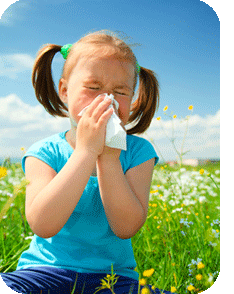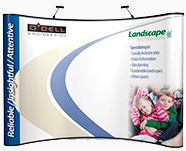Allergy Prevention in Outdoor Recreational Spaces
Author: Chad Kennedy, Landscape Architect, ASLA
 Early last summer, I watched as the family vegetable garden magically grew and started to flower. The corn stalks were beautiful shades of deep green, over 6' tall, and the tassel's (male flowers) were seemingly ready to pollinate the entire world. Knowing that corn is wind pollinated and that my small backyard would not afford prime conditions for wind pollination, I took it upon myself to act on behalf of the wind. With visions of sweet, juicy ripe ears of corn in mind, and not much else, I shook each stalk to loosen the pollen and watched as yellow specs danced around the lush green corn leaves forming a thin layer of yellow dust on everything below. Everything appeared ideal until I realized that I had not prepared for the hay-fever attack that ensued. Before long, I was sneezing, coughing and running for the garden hose to wash that same thin layer of pollen off my face, arms and clothes. Though I caused this scenario and, unmistakably, deserved the outcome, I can laugh about it today. Unfortunately, many face similar, and often more serious, experiences each time they attempt to recreate outdoors. In reality, many are not able to participate at all in recreational activities due to allergic reactions with elements in the outdoor landscape. In fact a story was recently published about a young elementary school student who, due to severe allergies, must attend class and interact with other students vicariously through a robot equipped with a camera and monitor.5 Plant selections at the design level can help limit some exposure to allergens. Often, limiting these allergens is a primary goal for schoolyards, healing gardens or playgrounds where particularly sensitive groups of people may spend time. Below are a few important concepts to be aware of when attempting to reduce allergens in the landscape:
Early last summer, I watched as the family vegetable garden magically grew and started to flower. The corn stalks were beautiful shades of deep green, over 6' tall, and the tassel's (male flowers) were seemingly ready to pollinate the entire world. Knowing that corn is wind pollinated and that my small backyard would not afford prime conditions for wind pollination, I took it upon myself to act on behalf of the wind. With visions of sweet, juicy ripe ears of corn in mind, and not much else, I shook each stalk to loosen the pollen and watched as yellow specs danced around the lush green corn leaves forming a thin layer of yellow dust on everything below. Everything appeared ideal until I realized that I had not prepared for the hay-fever attack that ensued. Before long, I was sneezing, coughing and running for the garden hose to wash that same thin layer of pollen off my face, arms and clothes. Though I caused this scenario and, unmistakably, deserved the outcome, I can laugh about it today. Unfortunately, many face similar, and often more serious, experiences each time they attempt to recreate outdoors. In reality, many are not able to participate at all in recreational activities due to allergic reactions with elements in the outdoor landscape. In fact a story was recently published about a young elementary school student who, due to severe allergies, must attend class and interact with other students vicariously through a robot equipped with a camera and monitor.5 Plant selections at the design level can help limit some exposure to allergens. Often, limiting these allergens is a primary goal for schoolyards, healing gardens or playgrounds where particularly sensitive groups of people may spend time. Below are a few important concepts to be aware of when attempting to reduce allergens in the landscape:
Minimizing Pollen Producers: It is estimated that within the United States one in five people suffer from allergies or asthma. In fact, allergies are also listed as the number five U.S. leading chronic disease.1 Pollens from unbalanced urban ecosystems are often blamed for much of this allergy epidemic and, perhaps, this is partially true. Many plants and grasses that produce pollen are the cause of many respiratory allergies. The worst offenders are the very plants that many cities and maintenance crews rave about and prefer to plant. This is because dioecious male plants (plants that produce only pollen) produce no fruit or seeds to clean up; they produce only pollen. On the other hand, the best plants for allergies are dioecious female plants (plants that produce no pollen).2 As a general rule, however, plants that produce showy, colorful flowers, are pollinated by insects rather than wind and, don't tend to cause issues for allergy suffers. The pollen grains in these flowers are larger, heavier and stickier in order to facilitate transfer between plant and insect. Hence the pollen doesn't travel far and isn't likely to enter the respiratory tract. Wind pollinated plants should be avoided as they tend to have light, dry pollen that can travel miles in windy conditions. Plants such as oaks, junipers, California lilac and Bermuda grass, among others, produce wind-driven pollen and are included in this category.4
There are a great number of commercial plants and varieties available today; it is important to know which ones will be less likely to cause allergies. A great resource for determining this is the OPALS system (Ogren Plant Allergy Scale). This system assigns a 1-10 allergy value to plants and has been used by many organizations concerned with allergies.
Encouraging Song Bird Presence: Encouraging populations of song birds in the landscape is another method for reducing allergies in the landscape. This may sound obscure, but in reality, plant species that sustain populations of song birds help keep insect infestations to a minimum. When insects that secrete sticky substances (such as aphids and scale) infest plants in large numbers, chances are, the leaves will get sticky and become prime locations for airborne mold. The molds then grow and produce large quantities of mold spores compounding allergy problems.3 Another option is to simply select plant types that are less susceptible to insect infestations.
Avoiding Irritating Plant Secretions: Many species of plants produce toxins as defense mechanisms to keep predators away. These toxins can be found in any part of the plant from the roots, leaves, seeds and fruit. Sometimes these toxins result in only minor irritation to the skin, but sometimes, when ingested, they can be fatal. In addition to the widely known plants such as poison ivy and poison oak, many common plant species used in traditional landscapes can cause irritations and rashes as well. Some of them include spurges, agapanthus, piracantha, juniper, euphorbias, walnuts and many others. Avoiding these plants will assure that most people can enjoy and interact with the environment without worrying about the repercussions of physically touching the plants.5
Though it is impossible and impractical to remove all potential allergens from the landscape, with a little effort, forethought and a knowledgeable designer, outdoor landscapes can be more accessible and enjoyable for all.
 Early last summer, I watched as the family vegetable garden magically grew and started to flower. The corn stalks were beautiful shades of deep green, over 6' tall, and the tassel's (male flowers) were seemingly ready to pollinate the entire world. Knowing that corn is wind pollinated and that my small backyard would not afford prime conditions for wind pollination, I took it upon myself to act on behalf of the wind. With visions of sweet, juicy ripe ears of corn in mind, and not much else, I shook each stalk to loosen the pollen and watched as yellow specs danced around the lush green corn leaves forming a thin layer of yellow dust on everything below. Everything appeared ideal until I realized that I had not prepared for the hay-fever attack that ensued. Before long, I was sneezing, coughing and running for the garden hose to wash that same thin layer of pollen off my face, arms and clothes. Though I caused this scenario and, unmistakably, deserved the outcome, I can laugh about it today. Unfortunately, many face similar, and often more serious, experiences each time they attempt to recreate outdoors. In reality, many are not able to participate at all in recreational activities due to allergic reactions with elements in the outdoor landscape. In fact a story was recently published about a young elementary school student who, due to severe allergies, must attend class and interact with other students vicariously through a robot equipped with a camera and monitor.5 Plant selections at the design level can help limit some exposure to allergens. Often, limiting these allergens is a primary goal for schoolyards, healing gardens or playgrounds where particularly sensitive groups of people may spend time. Below are a few important concepts to be aware of when attempting to reduce allergens in the landscape:
Early last summer, I watched as the family vegetable garden magically grew and started to flower. The corn stalks were beautiful shades of deep green, over 6' tall, and the tassel's (male flowers) were seemingly ready to pollinate the entire world. Knowing that corn is wind pollinated and that my small backyard would not afford prime conditions for wind pollination, I took it upon myself to act on behalf of the wind. With visions of sweet, juicy ripe ears of corn in mind, and not much else, I shook each stalk to loosen the pollen and watched as yellow specs danced around the lush green corn leaves forming a thin layer of yellow dust on everything below. Everything appeared ideal until I realized that I had not prepared for the hay-fever attack that ensued. Before long, I was sneezing, coughing and running for the garden hose to wash that same thin layer of pollen off my face, arms and clothes. Though I caused this scenario and, unmistakably, deserved the outcome, I can laugh about it today. Unfortunately, many face similar, and often more serious, experiences each time they attempt to recreate outdoors. In reality, many are not able to participate at all in recreational activities due to allergic reactions with elements in the outdoor landscape. In fact a story was recently published about a young elementary school student who, due to severe allergies, must attend class and interact with other students vicariously through a robot equipped with a camera and monitor.5 Plant selections at the design level can help limit some exposure to allergens. Often, limiting these allergens is a primary goal for schoolyards, healing gardens or playgrounds where particularly sensitive groups of people may spend time. Below are a few important concepts to be aware of when attempting to reduce allergens in the landscape:
